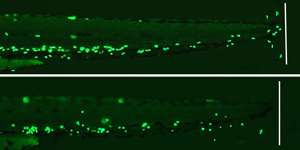Method reveals compounds that could help contain the effects of immunological disorders

Immune cells known as neutrophils are recruited by chemical signals released from sites of injury and infection. Their primary purpose is to attack pathogens and recruit additional immune defenses, but these cells can also inflict tissue damage through prolonged activation, contributing to serious diseases such as inflammatory bowel disease and chronic obstructive pulmonary disorder.
Philip Ingham and colleagues at the A*STAR Institute of Molecular and Cell Biology in Singapore have developed a fish-based screening technique that can rapidly identify compounds to potentially control such excessive neutrophil activation. Previously, Ingham collaborated with Stephen Renshaw's team at the University of Sheffield, UK, to generate a genetically modified zebrafish strain in which neutrophils are selectively labeled through production of a fluorescent protein.
The zebrafish model allowed for easy observation of neutrophil behavior in the transparent living zebrafish embryos and larvae. "We showed that neutrophil migration could be blocked by exposing fish larvae to known migration inhibitors," explains Ingham. Following on these findings, Ingham and Renshaw adapted the model to screen a library of fungal extracts and identify new molecules with similar migration-inhibiting effects.
"Most chemical screens in zebrafish use pure compounds of known chemical composition," says Ingham. "We were able to discover compounds with specific biological effects by screening fairly complex mixtures found in natural extracts."
Starting with over 1,000 extracts produced by Singapore-based company MerLion Pharmaceuticals, the researchers identified two extracts that inhibited neutrophil recruitment in zebrafish following tail injury. Fractionation of the two revealed the active ingredients responsible for the effect. Since one of the molecules had previously been linked to toxic effects, Ingham and colleagues focused on the other molecule, PF1052.
Notably, they found that PF1052 specifically blocks neutrophil migration to zebrafish tail wounds without affecting other immune cells (see image). They also found that the extract appears to block formation of the structures that coordinate cellular movement. It does this by interfering with the process of cellular polarization—the mechanism by which cells establish their relative orientation. Interestingly, PF1052 does not affect polarization via established mechanisms which, Ingham suggests, shows there is a novel route to controlling the inflammatory response.
Although the research effort was primarily intended as a proof-of-concept study, Ingham believes that it opens up wider possibilities and that the effects of PF1052 merit further investigation. "The next step would be to test PF1052 in an in vivo mammalian inflammation model to verify its efficacy and at the same time assess its potential toxicity," he says.
More information: Wang, X., Robertson, A. L., Li, J., Chai, R. J., Haishan, W. et al." Inhibitors of neutrophil recruitment identified using transgenic zebrafish to screen a natural product library." Disease Models & Mechanisms 7, 163–169 (2014). dx.doi.org/10.1242/dmm.012047
Renshaw, S. A., Loynes, C. A., Trushell, D. M. I., Elworthy, S., Ingham, P. W. & Whyte, M. K. B. "A transgenic zebrafish model of neutrophilic inflammation." Blood 108, 3976–3978 (2006). dx.doi.org/10.1182/blood-2006-05-024075



















